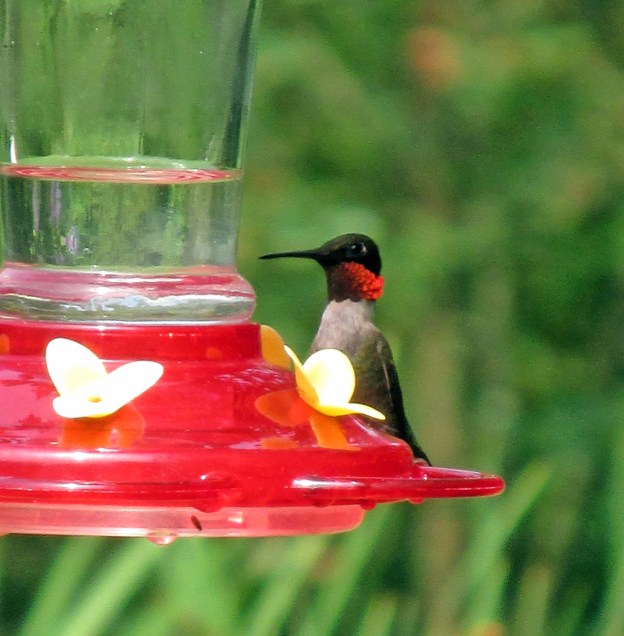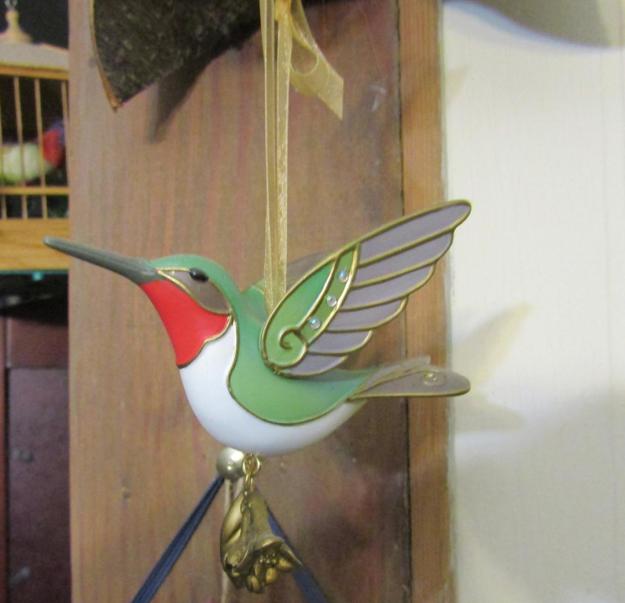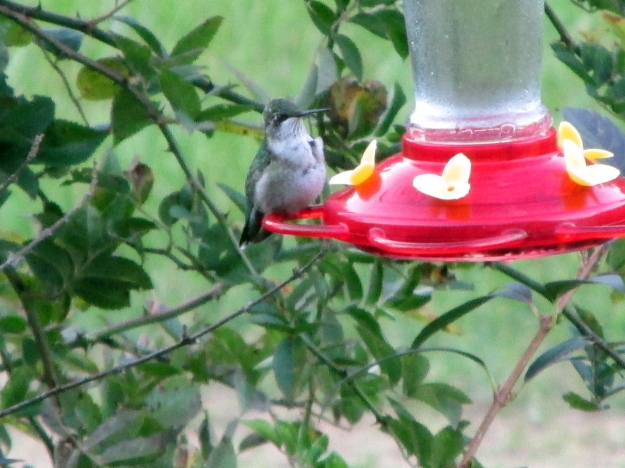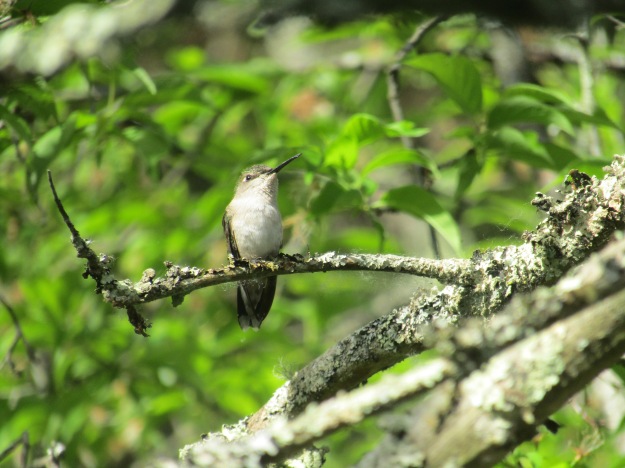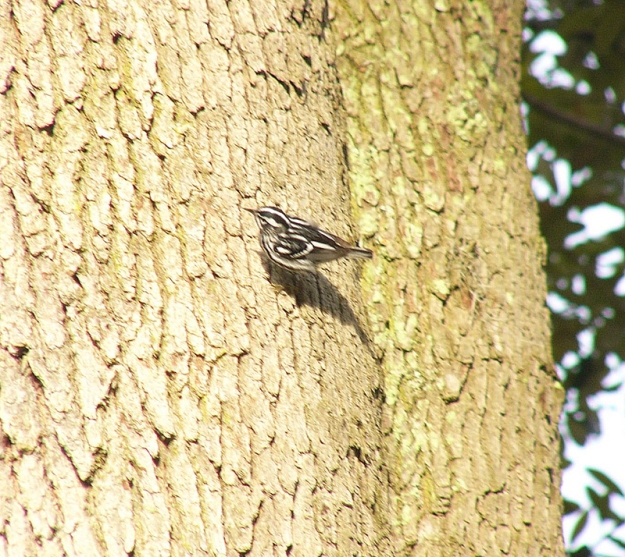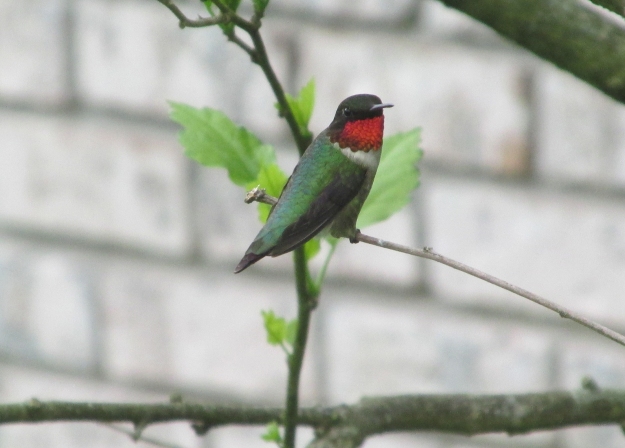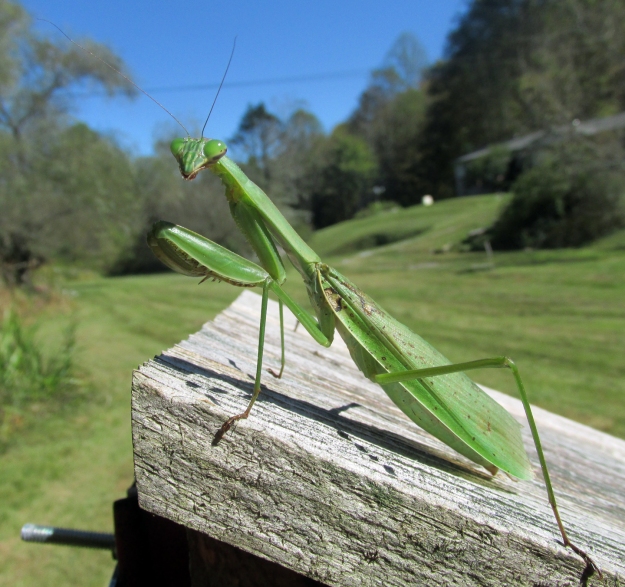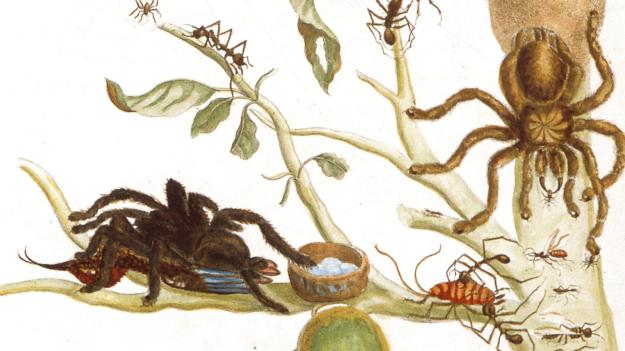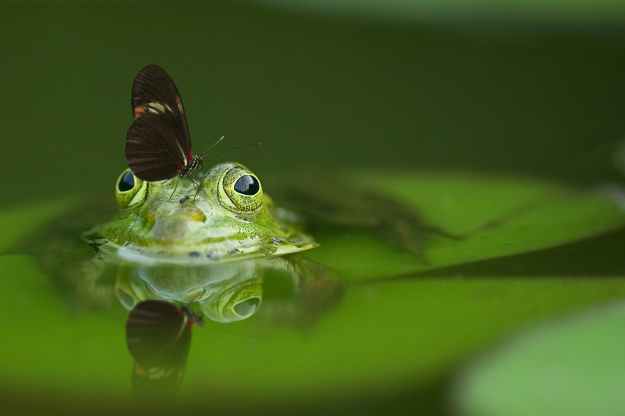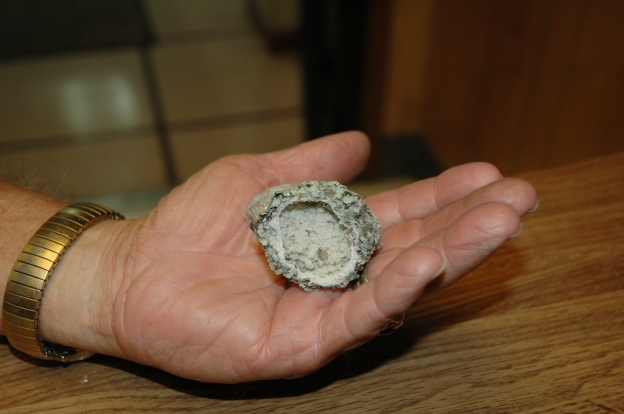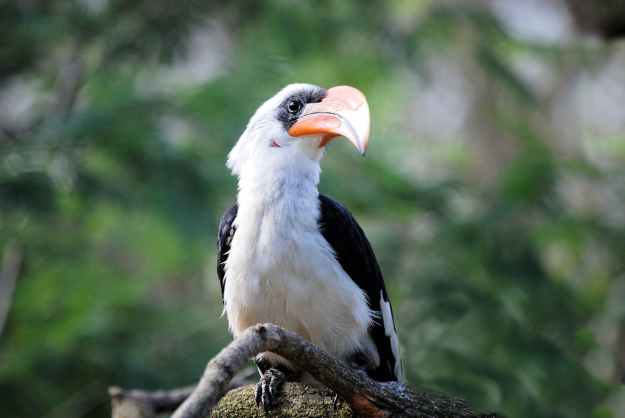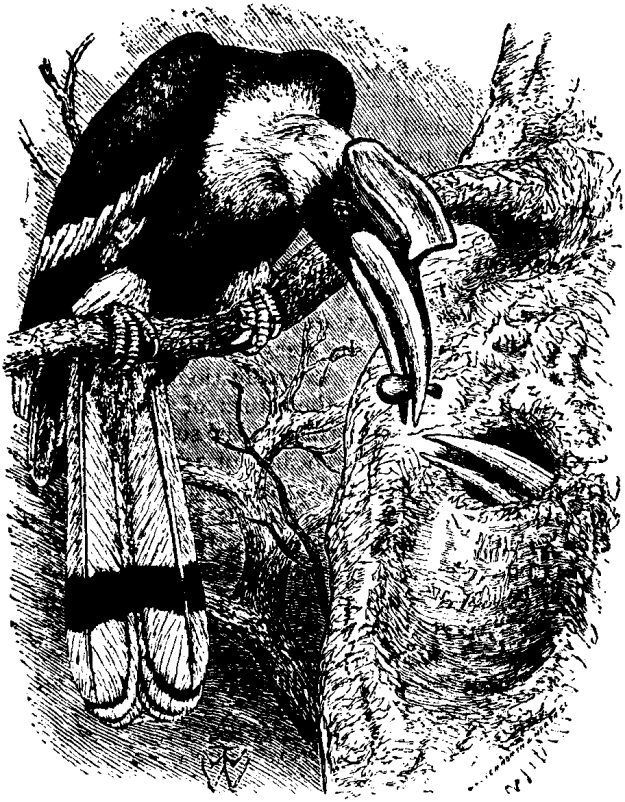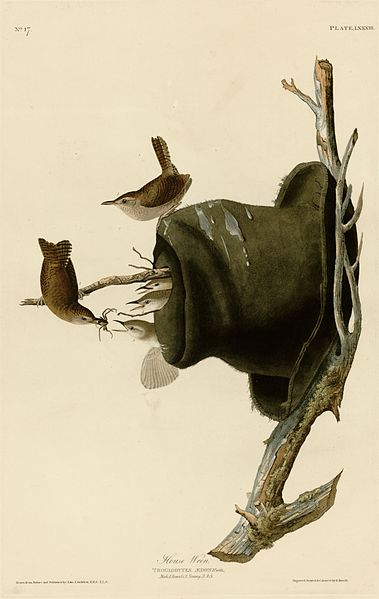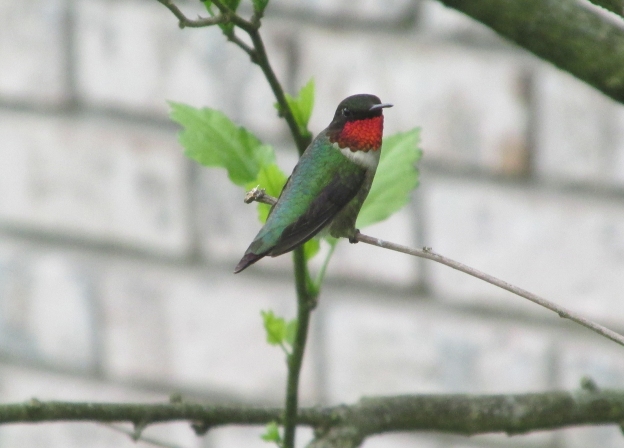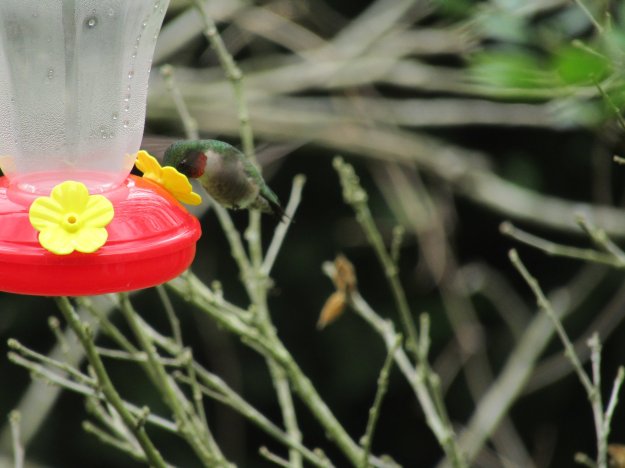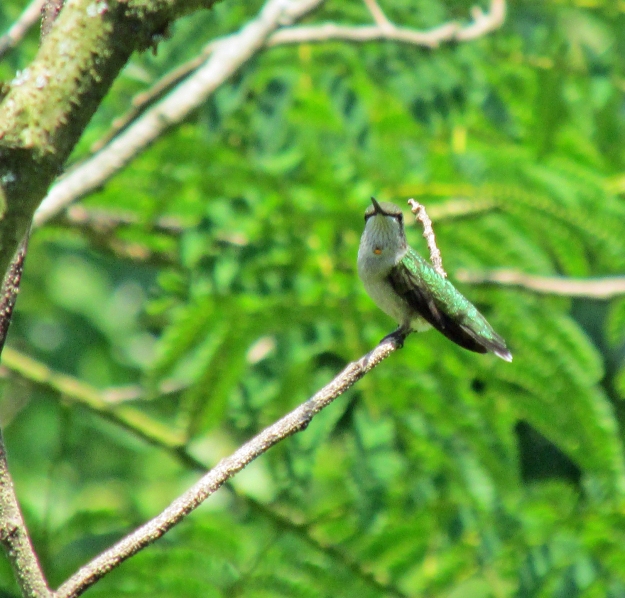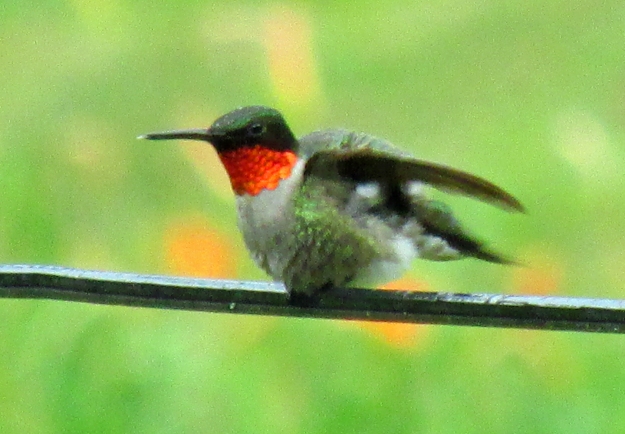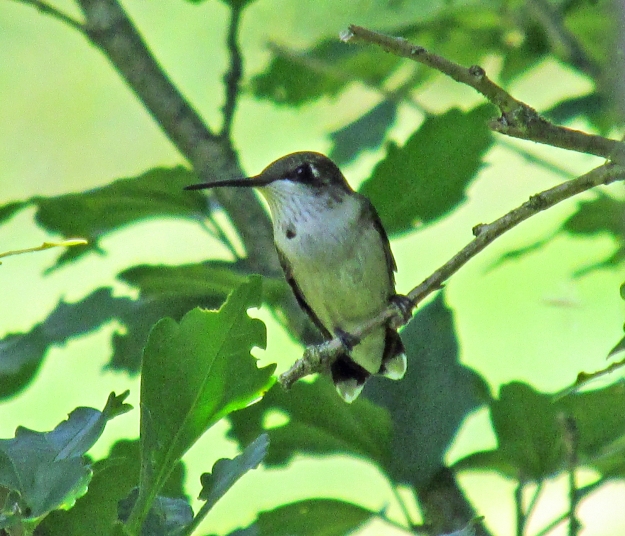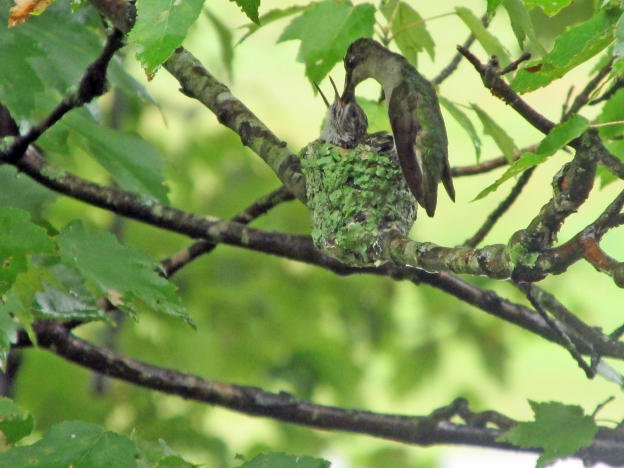
Photo by Bryan Stevens • Male ruby-throated hummingbirds show the namesake red throat. The feathers on a male’s throat are iridescent, which means they can change when seen from different angles. In poor light, the ruby-red throat can look almost black.
Bob Cheers, a resident of Plantation Road in Bristol, Virginia, sent an email to announce the arrival of his first hummingbird of spring at 6:20 p.m. on Wednesday, April 10.
“I put the feeder out April 2, which is earlier than previous years, after reading your March 31 article in the Bristol Herald Courier,” Bob wrote. “It brought to mind the one year that I failed to get the feeder out early and spotted a hummingbird hovering outside of my family room window, in the exact location my feeder has hung for the last 30 plus years. That little guy had to have been a repeat customer.”
Bob wrote that he’s intrigued by the fact that this year’s arrival date falls within the spread that ranges from April 9 to April 14 that he has established since he started recording the returns in 2009. “What triggers their departure from Central America and their guidance system, considering the variable winds encountered, that sends them back to my feeder within a five-day period each year?” Bob asked in his email.
I had to do some digging to find an answer to Bob’s question. According to the website, Hummingbird.net, the phenomenon of migration among hummingbirds is not well understood.
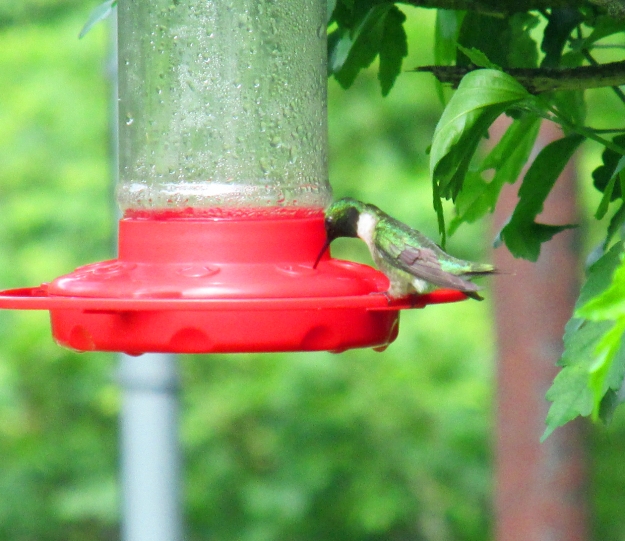
Photo by Bryan Stevens • A ruby-throated hummingbird sips from a sugar water feeder.
“Most ruby-throated hummingbirds winter between southern Mexico and northern Panama,” the website reveals. “Since hummingbirds lead solitary lives and neither live nor migrate in flocks, an individual bird may spend the winter anywhere in this range where the habitat is favorable, but probably returns to the same location each winter.”
The time they spend on this wintering range is remarkably brief. “Ruby-throats begin moving north as early as January, and by the end of February, they are at the northern coast of Yucatan, gorging on insects and spiders to add a thick layer of fat in preparation for flying to the United States,” the website notes.
According to the website, some hummingbirds skirt the Gulf of Mexico and follow the Texas coast north, while most apparently cross the Gulf, typically leaving at dusk for a nonstop flight of up to 500 miles, which takes 18 to 22 hours depending on the weather.
The force that compels hundreds of thousands of individual hummingbirds to all migrate at the same time remains mysterious. The reason these birds migrate is simpler. In the eastern half of the United States and Canada, ruby-throated hummingbirds face no competition from their own kind. If they remained in Central America, they would have to compete with dozens of species of hummingbirds during the nesting season. From the standpoint of the ruby-throated hummingbird, why not take a trip and claim a monopoly over some resource-rich terrain? It’s worked for these tiny flying jewels so far.
So, Bob became the first person to report a hummingbird arrival to me this year, but plenty of other people lined up to share their sightings, too.
Amy Wallin Tipton in Erwin, Tennessee, sent a message via Facebook to report her first hummingbird arrival for the spring. “Just saw my first hummer,” she wrote. Amy reported that the hummer, a male, arrived at 6:45 p.m. on Wednesday, April 10. “I’m so glad they are back,” she shared.
Ginger Brackins also reported that she saw her first ruby-throated hummingbird of spring on Wednesday, April 10, at her home in Erwin, Tennessee. She noted that it was a week earlier than last year. Ginger notes the arrival dates each year on her calendar. Ginger’s message about her sighting arrived thanks to her daughter, Gina McKinney, who emailed me on her mother’s behalf
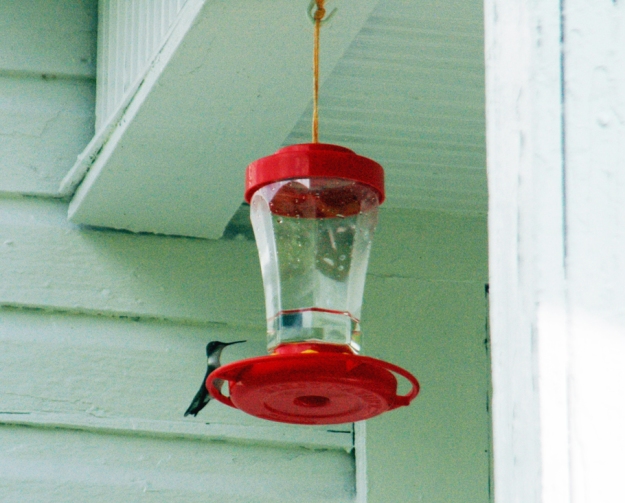
Photo by Bryan Stevens • Ruby-throated hummingbirds returned to the region in early April.
Joneen Sargent reported that her first hummingbird put in an appearance at 10 a.m. on Thursday, April 11, at her home in Bristol, Tennessee. In her email, she also asked if I had heard of downy woodpeckers drinking from sugar water feeders.
I answered her question by informing her that I’ve noticed downy woodpeckers, as well as Carolina chickadees, taking sips from my feeders. The chickadees can get quite acrobatic in their efforts to indulge their taste for sweets.
“We had our first male hummer at the feeder on Thursday, April 11, here in Bristol, Tennessee,” reported Tom and Sue Faucette in an email. “He came back on April 12-13.”
Lynne Reinhard reported that she saw her first hummingbirds of spring on Friday, April 12. “They are back!” Lynne proclaimed in a Facebook message. She wrote that the first hummingbird of the season arrived at 3 p.m. at her home on the upper end of South Holston Lake.
Snad Garrett saw her first hummingbird of spring on Stoney Creek in Elizabethton, Tennessee, on the evening of Friday, April 12.
Merry Jennings in Abingdon, Virginia, saw her first hummingbird on Friday, April 12, around 6 p.m., but hasn’t seen it since. “I put out the feeder on Thursday, April 11,” she noted in the email she sent me.
Lisa Brewer, who lives near Boone Lake in Piney Flats, Tennessee, reported that her first hummer arrived around 3 p.m. on Friday, April 12.
“I put my hummingbird feeders out last Sunday and had been watching every day for the first hummer to arrive,” she wrote in her email. “I was really excited to see a male ruby-throated hummingbird, and I saw what appeared to be the same one on Saturday and Sunday.”
Lisa added that this is the first year she has been able to get her feeders out in time for the first hummingbirds arriving in this area. “So I wanted to be sure to let you know when I saw my first one,” Lisa wrote.
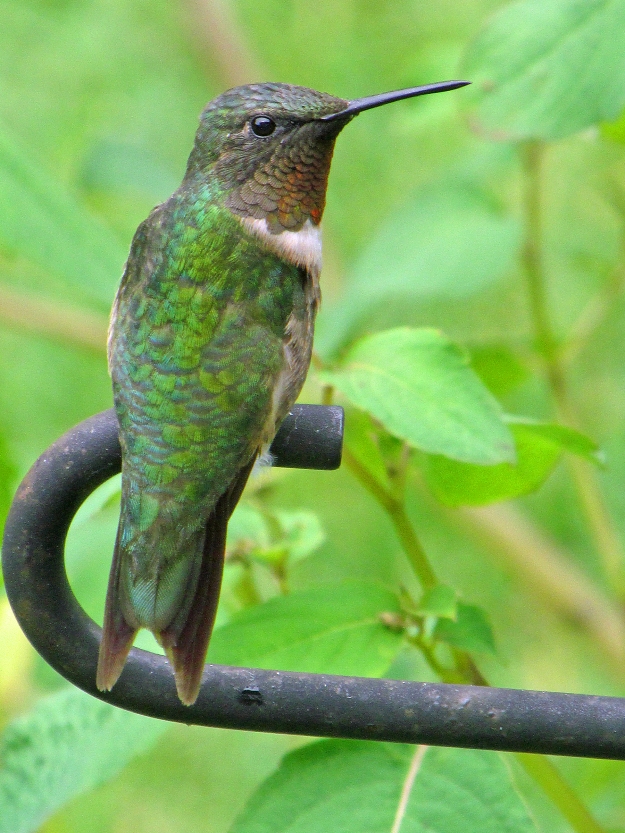
Photo by Bryan Stevens • Keep hummingbirds happy with a sugar water solution of four parts water to one part sugar.
Glen Eller saw his first hummingbird for the spring season on Friday, April 12, at 5:55 p.m. at his home in Fall Branch, Tennessee. “it was a male,” Glen reported in an email.
Karen Fouts posted on Facebook that she saw her first hummingbird of 2019 on Friday, April 12, at her home in Marion, Virginia. She also reported rose-breasted grosbeaks at her feeders.
Lois Cox and Wilma Boy reported their first male ruby-throat hummingbird on Saturday, April 13, at 2:30 p.m. at home in Bluff City, Tennessee. In her email, Lois noted that they needed to get out their feeders for the visiting bird. “It was a male,” Lois wrote in the email. “Hope it comes back.”
Deb Clark sent me an email on behalf of her mother and her sighting of a spring hummingbird. “My mother, Louise Tilson, has asked that I send you a message sharing her good news that she’s having hummingbirds at her backdoor feeder,” Deb wrote in the email.
Deb added that her mom lives in the Riverside community near Chilhowie, Virginia, on the banks of the South Fork of the Holston River. “She put out her feeder about a week ago,” Deb wrote. “The first little fellow showed up Friday, April 12, at about three-thirty in the afternoon.”
Deb relayed that her mother said the hummer came and perched on the feeder, drinking like he was starving.
Louise reported multiple visits by solitary male hummingbirds several times through Friday afternoon, but she wasn’t sure whether it was one bird making several trips or different birds.
Lane and Phyllis Duncan, who reside in the Rich Valley community in Smyth, Virginia, sent me an email to report their first hummer of spring on Friday, April 12, at 3:30 p.m.
Karen Shaffer sent me an email to announce the arrival of a hummingbird at her home. “I’m so excited to report we saw our first hummer on Saturday, April 13, at 11 a.m. at our home on Rich Valley Road, Bristol, near the Benhams and Nordyke communities.”
Karen said she heard the bird before she saw it. “It was visiting our blooming yellow holly bush,” she wrote. “Such a tiny thing — but vivid in color at the throat, so a male, I guess. Yay!”
Gloria Walter Blevins reported in a Facebook message that she saw her first hummingbird this spring on Friday, April 12, at her home in Damascus Virginia. The hummingbird — or another one — returned the following morning. Gloria also noted that she has bluebirds building a nest at her home.
Priscilla Gutierrez, Limestone Cove community in Unicoi County, Tennessee, reported on my Facebook page that she saw the first spring hummingbird Friday, April 12, at 6:45 p.m. “They have been coming ever since,” she noted.
April Kerns Fain in Erwin, Tennessee, posted about her hummingbird sightings on Saturday, April 13, on Facebook. “The hummingbirds are back,” she wrote. “I’ve seen a male at my feeders several times today.”

Photo by TheSOARnet / Pixabay.com • Male ruby-throated hummingbirds usually migrate ahead of females. These tiny birds must cross the Gulf of Mexico, without stopping, to reach their nesting grounds in the eastern United States. The journey across the Gulf can take them 18 to 22 hours, dependent on weather conditions.
Jane P. Arnold sent me an email to notify me of her mother’s hummingbird sighting. Her mother, Betty Poole, who lives in Abingdon, Virginia, saw her first hummingbird — a male — on Saturday, April 13. The following day, a female ruby-throated hummingbird also showed up at the feeder.
Jane added that she’s still waiting to see her own first hummingbird for the spring.
Helen Whited of Richlands, Virginia, reported her first spring hummingbird arrived on Saturday, April 13. “I just saw my first hummingbird of the season,” she wrote in her email. “Just one male so far. I have had my feeders out and waiting for a couple days. I thought this warm spring weather might bring in a few. So exciting!”
Sharee Bowman wrote a post on her Facebook page to announce her first spring hummer sighting on Saturday, April 13. “Hummingbird came yesterday to my feeder and, yes, it is the first one I have seen this year,” she wrote.
Felicia Mitchell saw her first spring hummingbird on Saturday, April 13. “He is happy to be home,” she reported in a comment on my Facebook page.
Brenda Hickman Dishner posted on my Facebook page about hummingbird arrivals. “They arrived at our house in Bristol, Tennessee, near Holston Dam on Highway 421, on Saturday, April 13, about 10:30 a.m.,” she wrote in her posting.
Vivian C. Tester sent me a Facebook message to report that she saw her first spring hummer at her home in Bristol, Tennessee, on Sunday, April 14.
Linda Kessinger Rhodes saw her first spring hummingbird visiting her feeders at her home in Tennessee Hills by the Walmart on the Parkway in Bristol, Tennessee, on Sunday, April 14. She posted her sighting on my Facebook page.

Photo by Bryan Stevens • A male ruby-throated hummingbird perches near a feeder that he is ready to defend from all comers.
Rhonda Eller saw her first hummingbird on Sunday, April 14, at 1:20 p.m. In her post on my Facebook page, she noted that she hung the feeder out last Wednesday before heading to Louisville to visit family. “I am always pleasantly surprised for the first spotting of one here on Horseshoe Bend in Chilhowie, Virginia,” she added. “Oh, the bluebirds are here, too, and have a nest with three eggs.”
Cheri Miller posted on my Facebook page about her sighting. “I saw one Sunday, April 14, in the Brown’s Branch community in Hampton, Tennessee, eyeing an orchid blooming in the window,” she wrote in her post.
Ron Bartlett reported by email that a single male showed up at his feeder on Sunday, April 14. “I live in McDowell County, North Carolina,” Ron shared. “This is about a week later than normal. Perhaps he was held up trying to cross the border.”
Donna Barnes Kilday of Erwin, Tennessee, posted to my Facebook page that she saw her first hummingbird of spring on the morning of Monday, April 15.
Janie Compton, a resident of Chesterfield, Virginia, saw her first hummingbird on Monday, April 15. Her friend, Phyllis Moore, posted news of Janie’s sighting on my Facebook page.
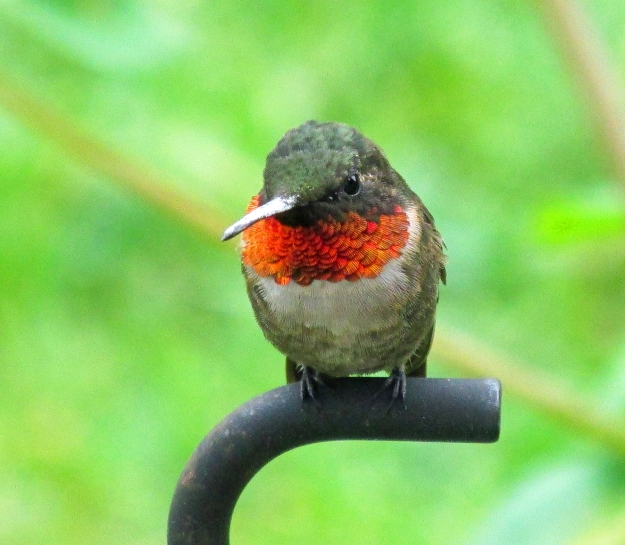
Photo by Bryan Stevens • Despite a perceived disadvantage of size, ruby-throated hummingbirds are quite capable of thriving in a giant world.
Emily Rogers, from Jonesborough, Tennessee, reported on my Facebook page that she had her first hummingbird of spring in Tennessee’s oldest town on Monday, April 15.
Linda K. Sproles of Bristol, Tennessee, got her first visit from a female hummingbird on Monday, April 15, in the late afternoon. Last year, she said her first sighting took place on Apr.14 while in 2017 she first saw a returning hummingbird on April 16.
Philip Laws, a resident of Limestone Cove in Unicoi County, Tennessee, saw his first hummingbird on Tuesday, April 16, at 4:20 p.m.
Tom and Cathy McNeil, who reside in the Piney Grove community of Hampton, Tennessee, reported their first spring hummingbird on Facebook on Tuesday, April 16.
I saw my first hummingbird this spring when a male visited several of my feeders around 5:30 p.m. on Tuesday, April 16. I enjoyed welcoming him home.
Readers are welcome to continue sharing their hummingbird sightings. Plenty of other colorful birds are also making spring migration stops, and I love to hear what everyone is seeing in their own yards. Email me at ahoodedwarbler@aol.com with questions, comments or observations.
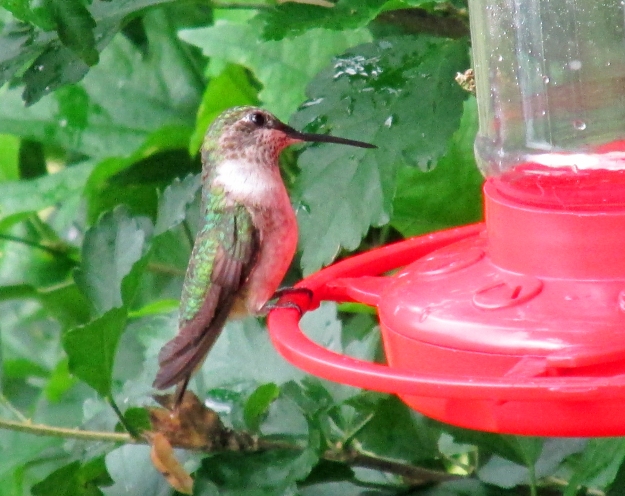
Photo by Bryan Stevens • A female ruby-throated hummingbird settles onto the perch of a sugar water feeder.





